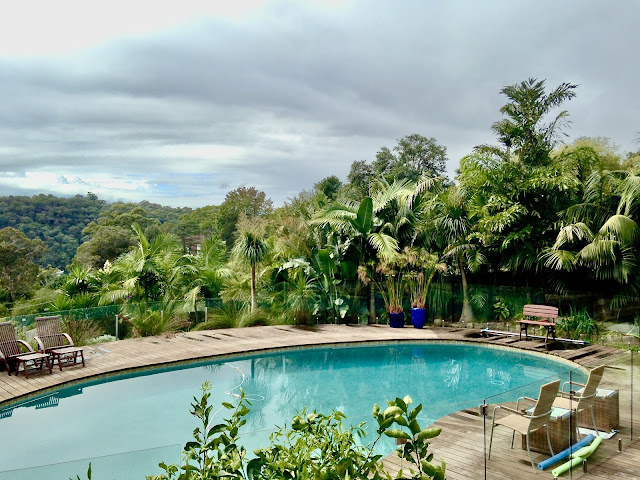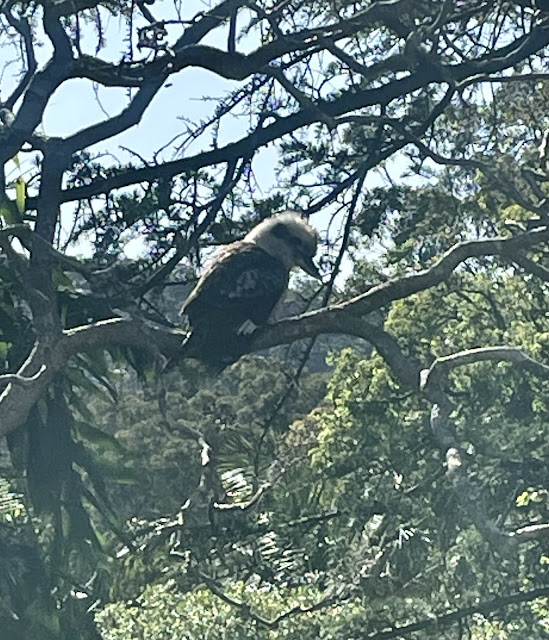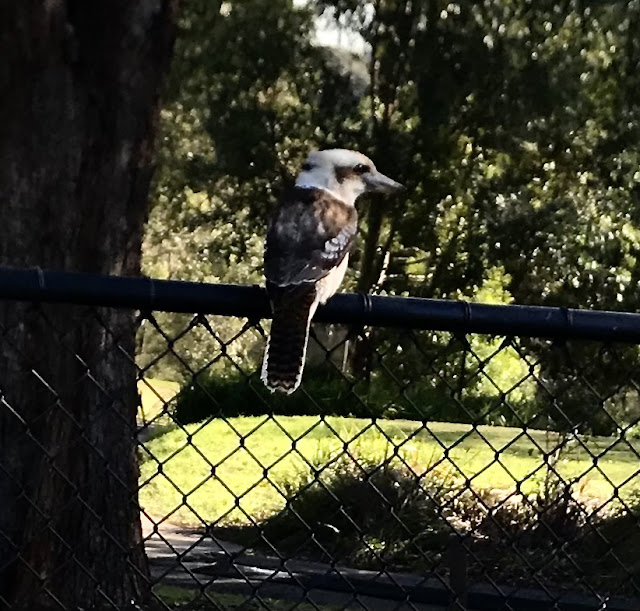 |
| Australian Laughing Kookaburra |
It happened so fast that I had no time to react, so I just stood there flabbergasted!
 |
| Photo of my co-grandmother's beautiful back garden and pool. |
The Kookaburra is a big bird, 18 inches long from beak to tail, and it’s the largest in the kingfisher family.
They can be aggressive when hunting or cornered but laid-back and very comfortable with people who pose no threat, so I was never in danger from a bird attack.
My sandwich, though, was an entirely different matter.
 |
| A Kookaburra, calculating where it will swoop next! |
These birds are exclusively carnivorous (meat-eaters) and will grab meat right off the grill while cooking.
Their heavy beaks work like tweezers, making stealing food easy.
Even though they are kingfishers, they eat more insects, spiders, frogs, reptiles, snakes, birds, rodents, etc., than fish.
However, they occasionally snatch goldfish out of backyard aquatic ponds.
Native to Australia, the Kookaburra is one of the country's most identifiable birds. I've spotted them perched in low and high places everywhere in Sydney.
 |
| My son-in-law's favorite place to nap is on the front garden hammock, although he may not want to rest there with the Kookaburra. |
The colors in the bird's plumage complement each other. Its back is a stunning brown, and on each wing is a striking patch of blue. Its chest is creamy white, and its tail is reddish-brown with white feathers on the tips.
 |
| This photo shows the bird's beautiful color harmony! |
 |
| A Kookaburra, spreading its wings! |
They are intelligent birds and can remember people's faces, which makes me wonder if this clever fellow will remember I was the sucker eating the sausage sandwich.
 |
| The creamy chest of the Kookaburra pops against the blue Aussie sky. |
The Kookaburra captured my attention again while I was vacationing with my family in a houseboat on the Hawkesbury River just outside Sydney.
Our beautiful weekend houseboat included a full kitchen, barbecue, fishing rods, bedrooms, a bathroom, a large upper deck, and lower decks wrapped around the boat.
 |
| Our beautiful houseboat! |
 |
| Dinghy |
Because Australia is in the Southern and Eastern Hemispheres, its galactic and intergalactic objects in space differ from those in the U.S. because the states are in the Northern and Western Hemispheres.
The brightest stars in the galaxy, like Sirius and Canopus, are in the Southern Hemisphere.
The commonly known Southern Cross constellation, which can also be seen from Australia, is depicted on the country's national flag.
Looking up from the top deck of the houseboat, I had never seen so many lights.
I was mesmerized by the starry night sky when the sound of a crying baby from a distance diverted my attention.
The crying quickly changed into a chorus of screeches, whirring, and cackles resembling the sound of a troop of chimpanzees in the deepest part of a jungle.
Right then and there, I knew what I knew: I was not in the U.S., and that was no crying baby!
Listen to the Kookaburra Cackle!
⬇
Stereotypical or not, like many Americans, I'm afraid of Australia's wildlife, many of which are deadly and found nowhere else on the planet.
So, when I heard creepy cackles coming from "Lord knows what" and "from who knows where," that was the last thing I needed, especially while docked in uncharted waters on an Australian river!
I asked my son-in-law about the eerie sounds, and he said, "Oh, that's just the Kookaburra's laughing."
My first thought was, "Kookaburra! That's that cheeky carnivore that ate my sandwich!"
My second was: "Not funny!"
 |
| Kookaburra perched on a goalpost at puppy park, looking back. |
While the Kookaburra's actual name comes from the aboriginal name "guuguuberra," it has other nicknames, like "bushman's clock" or "breakfast bird."
Their outrageous calls are so dependably vocal at dusk and dawn that you can set your watch by them - and loud enough that any creature with ears can hear them from miles away.
Bev, a friend from England who frequently visits Sydney, refers to the Kookaburra as the monkey bird, which cracks me up every time she says it!
 |
| This Kookaburra is showing off his best side. |
But the common nickname for this cheeky bird with a raucous voice is "Laughing Kookaburra."
It's got to be the coolest bird on the planet.
It's good-looking, has facial recognition abilities, a human personality type (thief), and outstanding vocal skills that mimic chuckling, crying, and laughter—which, when strung together, sounds like monkey chatter!
 |
| Kookaburra at the Oval car park. |
 |
| Forest areas in Australia are called "bush!" |
Australia's indigenous communities regard the Kookaburra as a messenger of good luck, joy, happiness, and fertility - good vibes!
Before visiting Sydney, I only knew about Kookaburras from a song I learned at Brownie camp, "Kookaburra Sits in the Old Gum Tree."
Marion Sinclair wrote it as a nursery rhyme.
My sister, Terry, and I loved singing the song at camp, but I admit I only really understood the lyrics after I got to know the bird!
 |
| A Kookaburra sitting in a gum tree, aka, eucalyptus. |
A crafty meat-eating bird that steals your lunch . . .
A talented, noisy bird, skillful at mimicking a repertoire of jungle sounds . . .
A brilliant bird with an extraordinary memory that can recognize human faces . . .
. . . I am NOT in Kansas!
Please sign into Google to leave a comment.

